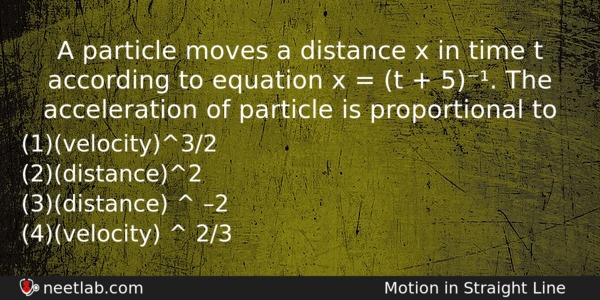| ⇦ | 
| ⇨ |
A particle moves a distance x in time t according to equation x = (t + 5)⁻¹. The acceleration of particle is proportional to
Options
(a) (velocity)^3/2
(b) (distance)^2
(c) (distance) ^ –2
(d) (velocity) ^ 2/3
Correct Answer:
(velocity)^3/2
Explanation:
x = 1 / t + 5
v = dx / dt = -1 / (t + 5)²
a = d²x / dt² = 2 / (t + 5)³ = 2x³
Now, 1 / (t + 5) ∞ v½
1 / (t + 5)³ ∞ v³/² ∞ a
Related Questions: - A step-up transformer operates on a 230 V line and supplies a current of 2 A.
- A plumb line is suspended form a ceiling of a car moving with horizontal acceleration
- The equivalent resistance of two resistors connected in series is 6 Ω
- Charge density for intrinsic semiconductor will be
- Energy of photon whose frequency is 10¹² MHz will be
Topics: Motion in Straight Line
(93)
Subject: Physics
(2479)
Important MCQs Based on Medical Entrance Examinations To Improve Your NEET Score
- A step-up transformer operates on a 230 V line and supplies a current of 2 A.
- A plumb line is suspended form a ceiling of a car moving with horizontal acceleration
- The equivalent resistance of two resistors connected in series is 6 Ω
- Charge density for intrinsic semiconductor will be
- Energy of photon whose frequency is 10¹² MHz will be
Topics: Motion in Straight Line (93)
Subject: Physics (2479)
Important MCQs Based on Medical Entrance Examinations To Improve Your NEET Score
18000+ students are using NEETLab to improve their score. What about you?
Solve Previous Year MCQs, Mock Tests, Topicwise Practice Tests, Identify Weak Topics, Formula Flash cards and much more is available in NEETLab Android App to improve your NEET score.
Share this page with your friends

Thankyou